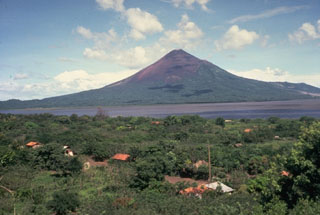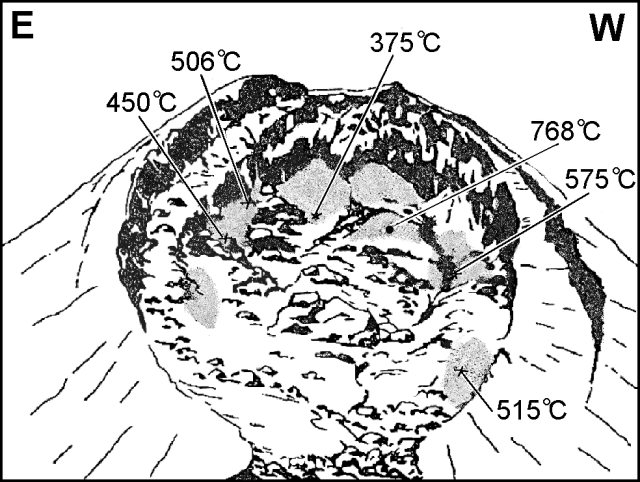Report on Momotombo (Nicaragua) — April 1996
Bulletin of the Global Volcanism Network, vol. 21, no. 4 (April 1996)
Managing Editor: Richard Wunderman.
Momotombo (Nicaragua) High seismicity and a black plume, but no crater changes
Please cite this report as:
Global Volcanism Program, 1996. Report on Momotombo (Nicaragua) (Wunderman, R., ed.). Bulletin of the Global Volcanism Network, 21:4. Smithsonian Institution. https://doi.org/10.5479/si.GVP.BGVN199604-344090
Momotombo
Nicaragua
12.423°N, 86.539°W; summit elev. 1270 m
All times are local (unless otherwise noted)
In the first days of April, strong seismic activity began beneath Momotombo. The seismic observations were made by the station located ~3 km from the crater and other stations of the national seismic network. A slight increase in activity had been observed during March. On 4 April the number of daily events reached ~100; seismicity remained high until 9 April with maximum magnitudes of about 3. On 9 and 10 April volcanic seismicity declined, but at 1510 on 10 on April a M 3.5 event occurred. Residents of La Paz Centro, ~15 km SW, saw a black cloud above the crater after the earthquake. The normal plume has a white color.
The 10 April earthquake was strongly felt at the geothermal power plant (30 MW), 5 km SW of the crater and <4 km from the epicenter. All but 12 people were evacuated from the power plant, which produces a considerable percentage of Nicaraguan electricity. Afterwards, until 0900 on 11 April, there were ~500 small events registered. On 11 April at 1600, some stronger events with magnitudes of about 3 were again recorded. All seismic events were impulsive, with frequencies of ~10 Hz, and very shallow. Small-amplitude tremor events lasted between some minutes and several hours. An overflight on 11 April to take photos and a video revealed no significant changes in the crater.
Crater fumarole temperatures reported by Alain Creusot have remained unchanged for the past year. During the last three inspections (25 February, 11 April, and 16 April) the maximum temperature was ~770°C. The six areas of fumarolic activity measured in April had temperatures ranging from 375 to 768°C (figure 4).
Geological Summary. Momotombo is a young stratovolcano that rises prominently above the NW shore of Lake Managua, forming one of Nicaragua's most familiar landmarks. Momotombo began growing about 4500 years ago at the SE end of the Marrabios Range and consists of a somma from an older edifice that is surmounted by a symmetrical younger cone with a 150 x 250 m wide summit crater. Young lava flows extend down the NW flank into the 4-km-wide Monte Galán caldera. The youthful cone of Momotombito forms an island offshore in Lake Managua. Momotombo has a long record of Strombolian eruptions, punctuated by occasional stronger explosive activity. The latest eruption, in 1905, produced a lava flow that traveled from the summit to the lower NE base. A small black plume was seen above the crater after a 10 April 1996 earthquake, but later observations noted no significant changes in the crater. A major geothermal field is located on the south flank.
Information Contacts: Wilfried Strauch and Martha Navarro, INETER, Apartado Postal 2110, Managua, Nicaragua; Alain Creusot, Instituto Nicaraguense de Energía, Managua, Nicaragua.


